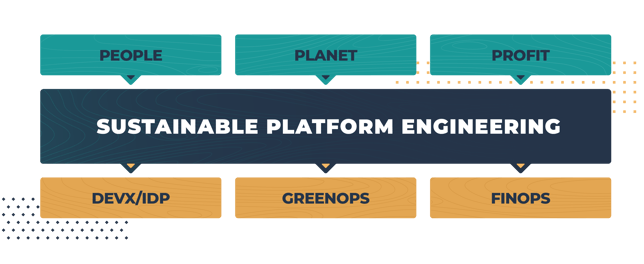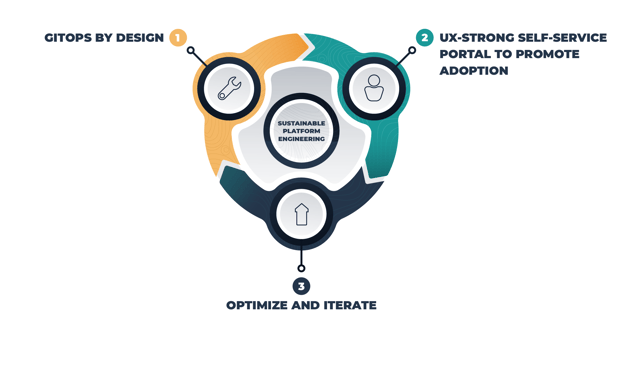What is sustainable platform engineering?
If you’re hanging around the Cycloid website, chances are you’re familiar with platform engineering and may well have already received the slightly worrying verdict on the topic delivered by the State of DevOps Report 2023 - Platform Engineering: on average, platform engineering takes 3 years to start showing its benefits to the wider organization!
If you have a platform team or have been thinking about initiating one, it’s galling reading. Although not unexpected, it is quite sobering - in today’s economic environment, can any business afford to implement a new strategy for three whole years without a single bit of payback? It doesn’t sound likely.
Building a platform and customizing it to your team’s preferences is a tempting trap to fall into - after all, you probably have your best men (and women) on the job. However, what most teams don’t consider is the long-term viability and upkeep of the platform, and simply the amount of effort it takes to keep it running smoothly. In other words, the platform’s sustainability is in question, which is why we’re here today to talk to you about the need for sustainable platform engineering - and no, we don’t mean that you should bring a reusable cup to the coffee shop on your way to work (although you should).
It’s significantly wider-reaching than that.
What is sustainability in the context of platform engineering?
Let us reclaim the term sustainability and bring it back to its roots. This concept goes beyond simply being “green”. In general, sustainability means meeting the needs of the present without compromising the ability of future generations to meet their needs. The definition comprises three pillars: economic, environmental, and social —also known informally as profits, planet, and people.

In the context of platform engineering, this means building the foundation and tools that are going to last and deliver a stable return on investment year after year. The idea is to modernize and streamline the infrastructure, as well as change the way your team interacts with it so that your business can weather any change.
In Cycloid’s book, this involves various aspects such as efficient use of resources, carbon footprint awareness, reproducibility, reusability through automation and self-service, scalability, standardization and governance, and optimization through monitoring and analytics.
Okay, but practically, how do I achieve sustainability?

We view sustainable platform engineering as an iterative cycle. When it comes to DIYing your platform tool, it isn’t the making of the beast that’s the killer - it’s the maintenance, upkeep, and usability of the platform as your business moves forward. This takes time, effort, and money, but in today's business environment, you can't just throw these variables at the problem and hope that you'll see radical results in 3 years.
Instead, you need to act strategically, choosing paths that will sustain your business in the long run. The three main areas to focus on are:
GitOps/Infra as code - start by optimizing your infra, modernizing it, and enjoying the benefits of infra as code. This protects your profits, allowing your business to keep moving forward and making an impact in a fast-moving technological world. Together, IAC and GitOps are what allow you to pick up speed and simplicity while maintaining a flawless end product.
Self-service - this is what’s going to help your people feel good about the work they do. A self-service tool with great UX removes the pressure on techs to be the infra experts they're not. At the same time, it erases the need for the endless tickets they used to raise, allowing your DevOps engineers and often, platform experts, time and space to do the “big thinking” that's going to help your business make and keep a leading edge.
Iteration and optimization - your self-service portal will bring flexibility to end-users while decreasing the number of tickets for the platform team. Do it right - or with the right partner - and it will also keep governance in check and control your cloud spending and carbon footprint impact, offsetting the environmental impact of your business while continuing to optimize people and profits. After all, the global tech market isn’t going to sit still, so your platform engineering tool can’t afford to either.
How does sustainable platform engineering affect the bottom line?
Sustainable platform engineering is meant to support the 3 main pillars of sustainability – profits, planet, and people, covering the major factors for a successful business.
Profit
Legacy infra, dysfunctional tech teams, and painfully slow production all contribute to a business that isn’t performing as it needs to. By modernizing legacy infrastructure, breaking down silos between teams, and accelerating production, platform engineering helps build a sustainable foundation that will continue to help bring in profits no matter the outside forces. Additionally, having an eye on your business expenses, such as the cost of the cloud, will keep your business a lean and mean machine.
Stable and secure ROI is the keyword of the day, and a business that is flexible enough to weather the changes and robust enough to keep going is the outcome of sustainable platform engineering.
Planet
A business that operates without an eye on the cost of its cloud resources is losing money and karma, plowing through energy and cloud costs at an eye-watering and unsustainable level. We’ve said it time and time again - billions of dollars paid for the cloud get wasted every year, putting a major dent not only in a company’s finances, but the real-life resources (water and electricity) sustaining the cloud.
This is where we put the “green” in sustainable platform engineering. By getting a hold of your cloud usage and controlling your cloud carbon footprint, your platform should be able to lessen the organization’s impact on the environment, saving both the green pastures and the green dollars (or colorful euros). But this is only achieved through a centralized and holistic overview of everything that gets deployed on the cloud, and everything that’s wasted.
People
A business that is pushing its capabilities to the limits in the search for success risks burning out its people and nowhere is this more obvious than on the tech team. Techs get stressed by having to interact with infra they know nothing about, DevOps and specialists get stressed by those techs desperately raising tickets in an attempt to get help, and platform engineers get stressed from the weight of providing a solution to these problems resting squarely on their shoulders. Stressed, desperate employees make bad decisions. By removing these pressures with a self-service portal (ideally complemented with tools around observability and governance), you’re releasing the cognitive workload on your team, allowing them to focus on what they do best. Better DevEx, happier people, better business.
As makers of a platform engineering tool, we’ve got skin in this game - but we believe we have a valid point: building a "homemade" platform engineering tool will likely backfire and compromise sustainability - not just of your project, but of the 3 fundamental pillars of sustainability.
If we’ve convinced you that platform engineering needs to be sustainable, great - because Cycloid is confident of it. Over the next few weeks, we’re going to look at the topic in more depth - today, we’ve shown you why and in future articles, we explore how to make it sustainable and why everyone on your tech team is going to benefit.
We'll add them below as they go online.
- What is sustainable platform engineering?
- Stepping into the future: modernising infra as the foundation of platform engineering
- How to build developer self-service your team will use
- Governance and security: finding the sustainability sweet spot

Read More
When should you adopt Platform Engineering?
If you’ve not been living under a rock for the last year and a half, chances are you’ve heard of...The future: modern infra as the foundation to platform engineering
Modernizing your infrastructure could take many forms. Artificial intelligence, GreenOps, FinOps,...Governance and security: finding the sustainability sweet spot
What makes a successful and sustainable platform engineering portal? Is it the level of...©2015-2022 Copyright Cycloid.io | Legal Notice


